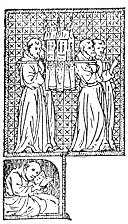
Sacred Texts Christianity Index Previous Next
Buy this Book at Amazon.com

The Writings of St. Francis of Assisi, tr. by Paschal Robinson, [1905], at sacred-texts.com
 |
In the first category, we must place the familiar letter in which St. Francis gives St. Antony permission to teach theology (Epistle III, in Wadding's edition), and which has been excluded by the Quaracchi editors as doubtful on the ground that it exists in too many different forms. 1 The letters to Brother Elias, to the Provincial Ministers, and to the Custodes (Epistles VII, IX, and XIV, in Wadding's edition), were translated by Wadding into Latin from a Spanish text, 2 and have not come down to us in their original form. Hence they do not figure in the Quaracchi edition. Neither does the letter (Epis. XVII, in Wadding's edition) to "Brother" Giacoma dei Settisoli, which is clearly an extract from Chapter XVIII of the Actus B. Francisci et Sociorum ejus. 3 Following the
[paragraph continues] Quaracchi editors, I have excluded these five letters from the present work.
As regards the reclassification of the other letters attributed to St. Francis by Wadding, Epistles IV, V, and XIII in his edition are without doubt genuine writings of St. Francis, but they are not letters; at least, the oldest MSS. do not give them in epistolary form. The two former are fragments of a "rule of life" and a "last wish," written by St. Francis for St. Clare; No. XIII is an Instruction on the Blessed Sacrament. All three are given elsewhere in the present volume in their proper form. 1 For the rest, the Epistles numbered I and II by Wadding form the text of one and the same letter "To all the Faithful;" those numbered VI and VIII seem to be a summary of the genuine letter "To a Minister," and No. X is part of the letter "To the General Chapter" also given below, while Epistles XI and XII form but one letter in the oldest codices and belong to this same letter to the General Chapter. The only two letters, then, of St. Francis which, both as regards matter and form, may be accepted as Wadding gives them, are numbers VIII and XV, addressed to the
[paragraph continues] Rulers and to Brother Leo respectively. In a word, as a result of this process of elimination and reclassification, only five of the seventeen letters ascribed to St. Francis by Wadding remain to us, namely:—
1. Letter to all the Faithful (Ep. I and II of Wadding).
2. Letter to the General Chapter (Ep. X, XI, and XII of Wadding).
3. Letter to a Minister (Ep. VI and VIII of Wadding).
4. Letter to the Rulers (Ep. XV of Wadding).
5. Letter to Brother Leo (Ep. XVI of Wadding).
To these five letters, the Quaracchi editors have added the undoubtedly authentic letter of St. Francis to the Custodes, 1 making six in all. Such are the six letters which I have here rendered into English. Let us now consider each of them in order.
93:1 On this letter see Appendix.
93:2 Wadding drew on the Spanish text of Rebolledo (Chron, P. I, l. II, c. xxvii) and himself appears to have had misgivings, at least as regards the authenticity of Epistle VII.
93:3 See Actus B. Francisci, etc., ed. Sabatier, p. 63. M. Sabatier attributes the authorship of this compilation (which contains, as is now known, among other matters, the original Latin text of the traditional Fioretti) to Fra Ugolino di Monte Giorgio, and believes its date to be between 1280 and 1320. It is, however, from Thomas of Celano that we know St. p. 94Francis to have written a letter to the Lady Giacoma (See Tr. de Miraculis in Anal. Bolland., t. xviii). See also Spec. Perf. (ed. Sabatier), c. XII, for reference to this letter. The narrative of Celano renders the text of the letter given in the Actus very doubtful. The fact that the expression "St. Mary of the Angels" is used in it to designate the Portiuncula is in itself sufficient to militate against its authenticity. Neither St. Francis nor his companions ever employed this term; they invariably said "St. Mary of the Portiuncula." Any document, therefore, containing the former expression bespeaks a fourteenth century origin at earliest. See Frère Jacqueline: Recherches Historiques, by Fr. Edouard d’Alencon, Paris, 1899.
94:1 See above, pp. 23, 77, 78.
95:1 The letter which Wadding translated from the Spanish, under this title and numbered XIV, appears to have been an incomplete version of the letter here given in full.